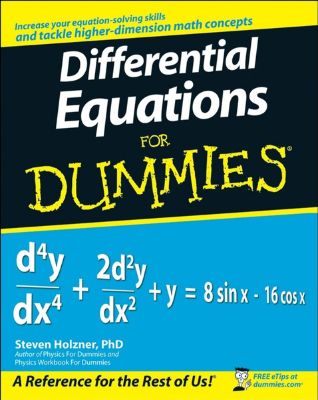
Lýsing:
The fun and easy way to understand and solve complex equations Many of the fundamental laws of physics, chemistry, biology, and economics can be formulated as differential equations. This plain-English guide explores the many applications of this mathematical tool and shows how differential equations can help us understand the world around us. Differential Equations For Dummies is the perfect companion for a college differential equations course and is an ideal supplemental resource for other calculus classes as well as science and engineering courses.
Annað
- Höfundur: Steven Holzner
- Útgáfa:1
- Útgáfudagur: 02-09-2008
- Hægt að prenta út 10 bls.
- Hægt að afrita 2 bls.
- Format:Page Fidelity
- ISBN 13: 9780470395660
- Print ISBN: 9780470178140
- ISBN 10: 0470395664
Efnisyfirlit
- Title Page
- Copyright Page
- Table of Contents
- Introduction
- About This Book
- Conventions Used in This Book
- What You’re Not to Read
- Foolish Assumptions
- How This Book Is Organized
- Part I: Focusing on First Order Differential Equations
- Part II: Surveying Second and Higher Order Differential Equations
- Part III: The Power Stuff: Advanced Techniques
- Part IV: The Part of Tens
- Icons Used in This Book
- Where to Go from Here
- Part I: Focusing on First Order Differential Equations
- Chapter 1: Welcome to the World of Differential Equations
- The Essence of Differential Equations
- Derivatives: The Foundation of Differential Equations
- Derivatives that are constants
- Derivatives that are powers
- Derivatives involving trigonometry
- Derivatives involving multiple functions
- Seeing the Big Picture with Direction Fields
- Plotting a direction field
- Connecting slopes into an integral curve
- Recognizing the equilibrium value
- Classifying Differential Equations
- Classifying equations by order
- Classifying ordinary versus partial equations
- Classifying linear versus nonlinear equations
- Solving First Order Differential Equations
- Tackling Second Order and Higher Order Differential Equations
- Having Fun with Advanced Techniques
- Chapter 2: Looking at Linear First Order Differential Equations
- First Things First: The Basics of Solving Linear First Order Differential Equations
- Applying initial conditions from the start
- Stepping up to solving differential equations involving functions
- Adding a couple of constants to the mix
- Solving Linear First Order Differential Equations with Integrating Factors
- Solving for an integrating factor
- Using an integrating factor to solve a differential equation
- Moving on up: Using integrating factors in differential equations with functions
- Trying a special shortcut
- Solving an advanced example
- Determining Whether a Solution for a Linear First Order Equation Exists
- Spelling out the existence and uniqueness theorem for linear differential equations
- Finding the general solution
- Checking out some existence and uniqueness examples
- Figuring Out Whether a Solution for a Nonlinear Differential Equation Exists
- The existence and uniqueness theorem for nonlinear differential equations
- A couple of nonlinear existence and uniqueness examples
- First Things First: The Basics of Solving Linear First Order Differential Equations
- Chapter 1: Welcome to the World of Differential Equations
- Chapter 3: Sorting Out Separable First Order Differential Equations
- Beginning with the Basics of Separable Differential Equations
- Starting easy: Linear separable equations
- Introducing implicit solutions
- Finding explicit solutions from implicit solutions
- Tough to crack: When you can’t find an explicit solution
- A neat trick: Turning nonlinear separable equations into linear separable equations
- Trying Out Some Real World Separable Equations
- Getting in control with a sample flow problem
- Striking it rich with a sample monetary problem
- Break It Up! Using Partial Fractions in Separable Equations
- Beginning with the Basics of Separable Differential Equations
- Chapter 4: Exploring Exact First Order Differential Equations and Euler’s Method
- Exploring the Basics of Exact Differential Equations
- Defining exact differential equations
- Working out a typical exact differential equation
- Determining Whether a Differential Equation Is Exact
- Checking out a useful theorem
- Applying the theorem
- Conquering Nonexact Differential Equations with Integrating Factors
- Finding an integrating factor
- Using an integrating factor to get an exact equation
- The finishing touch: Solving the exact equation
- Getting Numerical with Euler’s Method
- Understanding the method
- Checking the method’s accuracy on a computer
- Delving into Difference Equations
- Some handy terminology
- Iterative solutions
- Equilibrium solutions
- Exploring the Basics of Exact Differential Equations
- Chapter 5: Examining Second Order Linear Homogeneous Differential Equations
- The Basics of Second Order Differential Equations
- Linear equations
- Homogeneous equations
- Second Order Linear Homogeneous Equations with Constant Coefficients
- Elementary solutions
- Initial conditions
- Checking Out Characteristic Equations
- Real and distinct roots
- Complex roots
- Identical real roots
- Getting a Second Solution by Reduction of Order
- Seeing how reduction of order works
- Trying out an example
- Putting Everything Together with Some Handy Theorems
- Superposition
- Linear independence
- The Wronskian
- The Basics of Second Order Differential Equations
- The General Solution of Second Order Linear Nonhomogeneous Equations
- Understanding an important theorem
- Putting the theorem to work
- Finding Particular Solutions with the Method of Undetermined Coefficients
- When g(x) is in the form of erx
- When g(x) is a polynomial of order n
- When g(x) is a combination of sines and cosines
- When g(x) is a product of two different forms
- Breaking Down Equations with the Variation of Parameters Method
- Nailing down the basics of the method
- Solving a typical example
- Applying the method to any linear equation
- What a pair! The variation of parameters method meets the Wronskian
- Bouncing Around with Springs ’n’ Things
- A mass without friction
- A mass with drag force
- The Write Stuff: The Notation of Higher Order Differential Equations
- Introducing the Basics of Higher Order Linear Homogeneous Equations
- The format, solutions, and initial conditions
- A couple of cool theorems
- Tackling Different Types of Higher Order Linear Homogeneous Equations
- Real and distinct roots
- Real and imaginary roots
- Complex roots
- Duplicate roots
- Mastering the Method of Undetermined Coefficients for Higher Order Equations
- When g(x) is in the form erx
- When g(x) is a polynomial of order n
- When g(x) is a combination of sines and cosines
- Solving Higher Order Equations with Variation of Parameters
- The basics of the method
- Working through an example
- Chapter 9: Getting Serious with Power Series and Ordinary Points
- Perusing the Basics of Power Series
- Determining Whether a Power Series Converges with the Ratio Test
- The fundamentals of the ratio test
- Plugging in some numbers
- Shifting the Series Index
- Taking a Look at the Taylor Series
- Solving Second Order Differential Equations with Power Series
- When you already know the solution
- When you don’t know the solution beforehand
- A famous problem: Airy’s equation
- Pointing Out the Basics of Singular Points
- Finding singular points
- The behavior of singular points
- Regular versus irregular singular points
- Exploring Exciting Euler Equations
- Real and distinct roots
- Real and equal roots
- Complex roots
- Putting it all together with a theorem
- Figuring Series Solutions Near Regular Singular Points
- Identifying the general solution
- The basics of solving equations near singular points
- A numerical example of solving an equation near singular points
- Taking a closer look at indicial equations
- Breaking Down a Typical Laplace Transform
- Deciding Whether a Laplace Transform Converges
- Calculating Basic Laplace Transforms
- The transform of 1
- The transform of eat
- The transform of sin at
- Consulting a handy table for some relief
- Solving Differential Equations with Laplace Transforms
- A few theorems to send you on your way
- Solving a second order homogeneous equation
- Solving a second order nonhomogeneous equation
- Solving a higher order equation
- Factoring Laplace Transforms and Convolution Integrals
- Factoring a Laplace transform into fractions
- Checking out convolution integrals
- Surveying Step Functions
- Defining the step function
- Figuring the Laplace transform of the step function
- Introducing the Basics of Matrices
- Setting up a matrix
- Working through the algebra
- Examining matrices
- Mastering Matrix Operations
- Equality
- Addition
- Subtraction
- Multiplication of a matrix and a number
- Multiplication of two matrices
- Multiplication of a matrix and a vector
- Identity
- The inverse of a matrix
- Having Fun with Eigenvectors ’n’ Things
- Linear independence
- Eigenvalues and eigenvectors
- Solving Systems of First-Order Linear Homogeneous Differential Equations
- Understanding the basics
- Making your way through an example
- Solving Systems of First Order Linear Nonhomogeneous Equations
- Assuming the correct form of the particular solution
- Crunching the numbers
- Winding up your work
- Number Crunching with Euler’s Method
- The fundamentals of the method
- Using code to see the method in action
- Moving On Up with the Improved Euler’s Method
- Understanding the improvements
- Coming up with new code
- Plugging a steep slope into the new code
- Adding Even More Precision with the Runge-Kutta Method
- The method’s recurrence relation
- Working with the method in code
- Chapter 14: Ten Super-Helpful Online Differential Equation Tutorials
- AnalyzeMath.com’s Introduction to Differential Equations
- Harvey Mudd College Mathematics Online Tutorial
- John Appleby’s Introduction to Differential Equations
- Kardi Teknomo’s Page
- Martin J. Osborne’s Differential Equation Tutorial
- Midnight Tutor’s Video Tutorial
- The Ohio State University Physics Department’s Introduction to Differential Equations
- Paul’s Online Math Notes
- S.O.S. Math
- University of Surrey Tutorial
- Chapter 15: Ten Really Cool Online Differential Equation Solving Tools
- AnalyzeMath.com’s Runge-Kutta Method Applet
- Coolmath.com’s Graphing Calculator
- Direction Field Plotter
- An Equation Solver from QuickMath Automatic Math Solutions
- First Order Differential Equation Solver
- GCalc Online Graphing Calculator
- JavaView Ode Solver
- Math @ CowPi’s System Solver
- A Matrix Inverter from QuickMath Automatic Math Solutions
- Visual Differential Equation Solving Applet
UM RAFBÆKUR Á HEIMKAUP.IS
Bókahillan þín er þitt svæði og þar eru bækurnar þínar geymdar. Þú kemst í bókahilluna þína hvar og hvenær sem er í tölvu eða snjalltæki. Einfalt og þægilegt!Rafbók til eignar
Rafbók til eignar þarf að hlaða niður á þau tæki sem þú vilt nota innan eins árs frá því bókin er keypt.
Þú kemst í bækurnar hvar sem er
Þú getur nálgast allar raf(skóla)bækurnar þínar á einu augabragði, hvar og hvenær sem er í bókahillunni þinni. Engin taska, enginn kyndill og ekkert vesen (hvað þá yfirvigt).
Auðvelt að fletta og leita
Þú getur flakkað milli síðna og kafla eins og þér hentar best og farið beint í ákveðna kafla úr efnisyfirlitinu. Í leitinni finnur þú orð, kafla eða síður í einum smelli.
Glósur og yfirstrikanir
Þú getur auðkennt textabrot með mismunandi litum og skrifað glósur að vild í rafbókina. Þú getur jafnvel séð glósur og yfirstrikanir hjá bekkjarsystkinum og kennara ef þeir leyfa það. Allt á einum stað.
Hvað viltu sjá? / Þú ræður hvernig síðan lítur út
Þú lagar síðuna að þínum þörfum. Stækkaðu eða minnkaðu myndir og texta með multi-level zoom til að sjá síðuna eins og þér hentar best í þínu námi.
Fleiri góðir kostir
- Þú getur prentað síður úr bókinni (innan þeirra marka sem útgefandinn setur)
- Möguleiki á tengingu við annað stafrænt og gagnvirkt efni, svo sem myndbönd eða spurningar úr efninu
- Auðvelt að afrita og líma efni/texta fyrir t.d. heimaverkefni eða ritgerðir
- Styður tækni sem hjálpar nemendum með sjón- eða heyrnarskerðingu
- Gerð : 208
- Höfundur : 10588
- Útgáfuár : 2008
- Leyfi : 380


